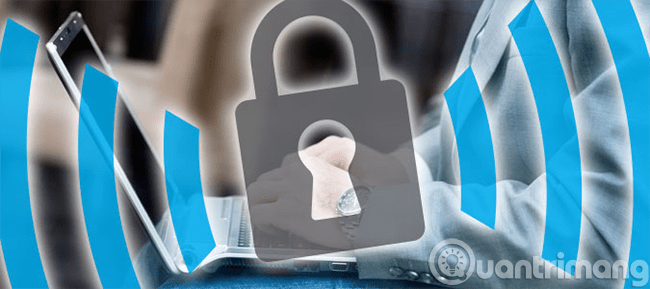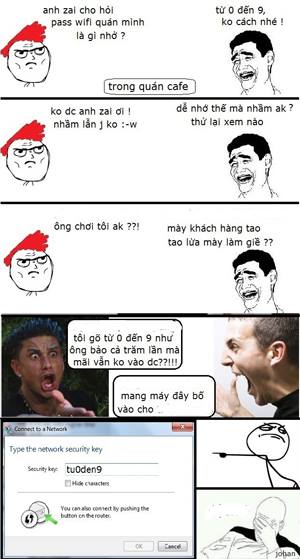Theory - Wifi security: next to the password protected layer
What is Wifi? Is the wireless network that we still use every day, at home, in the office, at the cafe . And if we consider the basic theory, what is the Wifi password? Do you know other than how to set password for Wifi, are there any other security methods? We often discuss the same issues in the following article of TipsMake.com.

1. Basic structure:
On the basic theory, you can imagine that the working principle of Wifi passwords would be like this:
- Wifi password will have the main task of encrypting all data transmitted and transmitted through modem device, router, and prevent other devices from connecting to the network if there is no password.
- We need to distinguish and know that: Wi-Fi Protected Access (WPA2) mode is the main security function along with Personal mode (PSK) only suitable for home use, small stores, and mode Enterprise with 802.1X security layer is better compatible with networks in large enterprises.
2. Firmware update and upgrade:

When choosing to use Modem, Router, you absolutely should not skip this step. That is to check and update Firmware - control software to the latest stable version. The best way is to check directly on the home page of the major and reputable equipment suppliers in the world. You can refer to the link below:
- TP-Link
- LinkSys
- Cisco
- Buffalo
- .
3. Choose a flexible Wifi name:
When setting up and configuring Wifi, make sure you change the name of Wifi - SSID (full Service Set Identifier ) by default. If you are lazy, keep the default name (usually in the form of tplink-wireless, linksys-wifi .) and set a password, it will be easier for hackers to crack the Pre-Shared Key (PSK) . Why is it easy to say here? This is because the SSID information used in the hash process to generate the key - the password, and the rainbow data sheet optimized for Brute Force Cracking is mainly applied to the default SSID.
Another problem with the default SSID, is that the wifi transceivers are virtually indistinguishable from the differences between Wifi systems with the same SSID. This will lead to the computer, the mobile phone will automatically connect to those SSIDs and lead to instability.
One more delicate reason is that the other people are familiar. If you keep 1 SSID from year to year, many people will accidentally connect to your Wi-Fi system, even if they just pass through your office, cafe . Changing SSID periodically will help limit this problem.
4. Change admin password and restrict access:

Similar to SSID, changing Wifi passwords is often recommended by security solution providers. Time is 1 week 1 time or 3 times in 1 month. Because changing Wifi password is also quite simple, it does not take much time that few people do too. How to set a password is easy to remember, you just need to follow the rules:
- Avoid sensitive, easy-to-remember information like shop owner's name, phone number, birthday .
- Instead, there are some good news, including numbers and special characters. For example: Hoilamgi1234 @ , Khongcospass && . for example
Some device vendors have additional access restrictions - Control Access in their products. You can set restrictions via the firewall, or turn off access to admin rights via LAN, WLAN, or directly from Wi-Fi.
- See the instructions for blocking websites with Router TP Link
5. Turn off the Wi-Fi Protected Setup (WPS) feature:
This function is designed to make Wifi signal encryption process faster and easier. Users just need to select, or enter the PIN code. However, this approach contains a lot of security holes, allowing hackers to take advantage to unlock PIN, thereby gaining access and controlling all Wifi transceivers. Pretty dangerous right?
Hopefully the above information can help you better understand the process of establishing and securing the Wifi system.Good luck!
You should read it
- What is WiFi 6E? How is WiFi 6E different from WiFi 6?
- How to check who is using Wifi temple, your home WiFi theft
- What is WiFi 6? What is WiFi 6E? Things you need to know about WiFi 6 and WiFi 6E
- How easy is Crack WiFi?
- How to change Wifi password, change wifi pass VNPT, FPT, Tenda, TP-Link, Viettel on computer, phone
- How to change FPT WiFi password
- How to view saved Wifi passwords on Android?
- How to hack pass wifi with WiFi Map everywhere
May be interested
- How to view saved Wifi passwords on Windows 7/8/10
 forgetting your wi-fi password can quickly become an obstacle, but don't panic. if you have a pc or mac connected to that wireless network, today's article will show you how to retrieve the forgotten password.
forgetting your wi-fi password can quickly become an obstacle, but don't panic. if you have a pc or mac connected to that wireless network, today's article will show you how to retrieve the forgotten password. - How easy is Crack WiFi?
 no matter how much you use your computer, you know a little bit about wifi security, sometimes even more confident when using many ways to protect your wifi. but are they really effective?
no matter how much you use your computer, you know a little bit about wifi security, sometimes even more confident when using many ways to protect your wifi. but are they really effective? - 2 steps to change Linksys wifi password
 if you find that your home wi-fi connection is slowing down recently, even if the charges are increasing for unknown reasons, then it is possible that your home wi-fi network has been stolen. the only solution is to quickly change your wifi password. in the article below, we will guide you to change linksys wifi password. please consult.
if you find that your home wi-fi connection is slowing down recently, even if the charges are increasing for unknown reasons, then it is possible that your home wi-fi network has been stolen. the only solution is to quickly change your wifi password. in the article below, we will guide you to change linksys wifi password. please consult. - How to change VNPT WiFi password
 change vnpt wifi password you need to pay attention to the type of modem you are using, depending on each vnpt modem but how to change the wifi pass vnpt is also different. here are the specific instructions for you guys.
change vnpt wifi password you need to pay attention to the type of modem you are using, depending on each vnpt modem but how to change the wifi pass vnpt is also different. here are the specific instructions for you guys. - Instructions for changing Viettel WiFi modem password
 the operation of changing viettel wifi password is essential, to be able to secure personal wifi, as well as to ensure the internet connection speed is stable.
the operation of changing viettel wifi password is essential, to be able to secure personal wifi, as well as to ensure the internet connection speed is stable. - How to change wifi password Tenda?
 changing pass wifi tenda will help protect your wifi network from being used by temples. if you do not know how to change wifi tenda password, please see this detailed guide.
changing pass wifi tenda will help protect your wifi network from being used by temples. if you do not know how to change wifi tenda password, please see this detailed guide. - How to view saved Wifi passwords on Android?
 by default when you enter the wifi password on the android device, it will automatically remember the password for the next visit. when your friends and relatives come to play, they want to ask for a wifi password to access the network that you forgot. what should you do in this case?
by default when you enter the wifi password on the android device, it will automatically remember the password for the next visit. when your friends and relatives come to play, they want to ask for a wifi password to access the network that you forgot. what should you do in this case? - How to check who is using Wifi temple, your home WiFi theft
 the network administrator will guide you how to see who is using wifi temple with wifi management software and some tips to detect if your wifi network connection is being stolen and to find ways to prevent the situation. that again.
the network administrator will guide you how to see who is using wifi temple with wifi management software and some tips to detect if your wifi network connection is being stolen and to find ways to prevent the situation. that again. - How to connect a computer to Wi-Fi without a password on Windows 10
 you want to connect a new computer to the internet via wi-fi but can't remember the password? want to quickly connect your computer to a modem or router without entering a password? here's how to use the wi-fi protected setup (wps) feature to connect to a wi-fi network without entering a password.
you want to connect a new computer to the internet via wi-fi but can't remember the password? want to quickly connect your computer to a modem or router without entering a password? here's how to use the wi-fi protected setup (wps) feature to connect to a wi-fi network without entering a password. - How to change the TP-Link wifi password?
 in the previous posts, tipsmake.com showed you how to change linksys wifi password and tenda. today, we will share with you how to change the wifi password of tp-link, also a very popular router in vietnam market. please consult.
in the previous posts, tipsmake.com showed you how to change linksys wifi password and tenda. today, we will share with you how to change the wifi password of tp-link, also a very popular router in vietnam market. please consult.










 Learn about DNS Hijacking and how to prevent it!
Learn about DNS Hijacking and how to prevent it! How to protect folders with Secure Folder?
How to protect folders with Secure Folder? Some software helps computers, laptops to play free Wifi
Some software helps computers, laptops to play free Wifi Instructions for removing LSE on Lenovo computers
Instructions for removing LSE on Lenovo computers Top 10 brilliant hackers
Top 10 brilliant hackers Destroying Vietnamese hackers attacking the network in the UK
Destroying Vietnamese hackers attacking the network in the UK